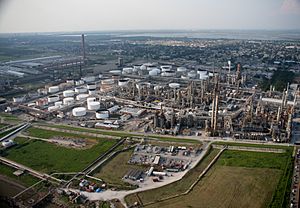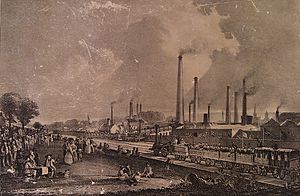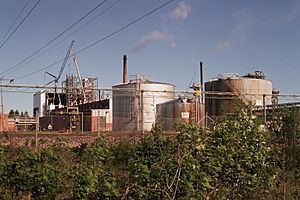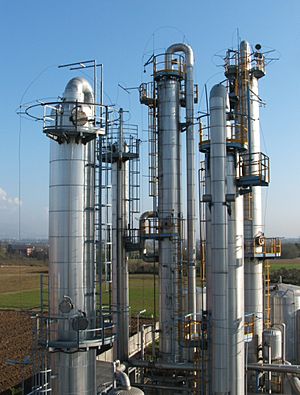Chemical industry facts for kids

The chemical industry is made up of companies that create and produce different kinds of chemicals. These chemicals are used in many ways, from making everyday products to helping other industries. This industry is super important for the modern world economy. It takes basic stuff like oil, natural gas, air, water, metals, and minerals and turns them into useful items for homes and businesses. Sometimes, companies in the chemical industry also make plastics, so there's a bit of overlap with the plastics industry. Many experts work here, including chemical engineers, chemists, and lab technicians.
Contents
How Did the Chemical Industry Start?
People have always made and used chemicals, but the heavy chemical industry – meaning making huge amounts of chemicals for many uses – really began with the Industrial Revolution.
Early Chemical Factories
One of the first chemicals made in large amounts was sulfuric acid. In 1736, a pharmacist named Joshua Ward found a way to make it by heating saltpeter. Later, in 1749, John Roebuck and Samuel Garbett opened a big factory in Scotland to produce it.
Around the same time, people used old methods like stale urine or sour milk to bleach cloth. This was slow! Sulfuric acid and lime helped speed things up. Then, Charles Tennant discovered bleaching powder. This powder was made by mixing chlorine with dry slaked lime. It was cheap and worked great! Tennant opened a factory in St Rollox, near Glasgow, and production quickly grew from 52 tons to almost 10,000 tons in just five years.

Soda ash has been used for ages to make glass, textiles, soap, and paper. In Europe, it used to come from wood ashes. But by the 1700s, this wasn't practical anymore because too many trees were cut down. The French Academy of Sciences even offered a prize for a way to make alkali from sea salt (sodium chloride). Nicolas Leblanc patented the "Leblanc process" in 1791, but he didn't get his prize money because of the French Revolution.
In Britain, the Leblanc process became very popular. Factories like James Muspratt's in Liverpool and Charles Tennant's near Glasgow became huge chemical centers. By the 1870s, Britain made more soda than all other countries combined!
These big factories started making more types of chemicals as the Industrial Revolution grew. At first, making soda created a lot of waste that polluted the environment. This led to one of the first environmental laws in 1863, which checked factories and fined them for pollution. Scientists then found ways to turn this waste into useful products.
A new method called the "Solvay process" was invented by Ernest Solvay in Belgium in 1861. This new process was cheaper and caused less pollution than the Leblanc method. It quickly became popular around the world. Ludwig Mond brought the Solvay process to England, making it a big commercial success.
In the early 1800s, people also started making chemical products from fossil fuels. For example, leftovers from making coal gas (used for lighting) were turned into things like naphtha and creosote. Later, they also made Ammonium sulphate fertilizer and asphalt for roads.
Growing and Developing
The late 1800s saw a huge increase in both the amount and variety of chemicals made. Big chemical industries grew in Germany and later in the United States.

Sir John Lawes was a pioneer in making artificial fertilizer for farming. He set up large factories near London in the 1840s to make "superphosphate of lime." Around the same time, processes for making rubber stronger (called vulcanization of rubber) were patented in the US and England.
The first artificial dye was discovered by William Henry Perkin in London. He turned a chemical called aniline into a bright purple substance. He also created the first synthetic perfumes. German companies like BASF, Bayer, and Hoechst quickly became leaders in synthetic dyes, producing almost 90% of the world's supply by 1913. In the US, Herbert Henry Dow used electricity to make chemicals from brine, helping the American chemical industry grow.
The petrochemical industry, which makes chemicals from oil, began in the early 1800s. The first plastic was invented by Alexander Parkes in 1856. He called it Parkesine, and it was an early type of celluloid. It showed how plastics could be used for many things. The industrial production of soap from vegetable oils also started in 1885, using modern chemical processes.
By the 1920s, chemical companies started joining together to form huge groups called conglomerates. Examples include IG Farben in Germany, Rhône-Poulenc in France, Imperial Chemical Industries in Britain, and DuPont in America.
What Products Does the Chemical Industry Make?
The chemical industry makes a huge variety of products. About 80% of what it produces worldwide are polymers and plastics, like polyethylene (used in plastic bags and bottles) and polyvinyl chloride (used in pipes). These materials are often used to make other things.
Chemicals are found in many everyday items and are used in different industries like farming, manufacturing, construction, and services. Big customers include companies that make rubber and plastic products, textiles, clothes, paper, and metals. The chemical business is worth nearly $3 trillion globally!
Chemical products can be grouped into a few main types:
- Basic chemicals (about 35-37% of sales)
- Life sciences (30%)
- Specialty chemicals (20-25%)
- Consumer products (about 10%)
Basic Chemicals

Basic chemicals, also called "commodity chemicals," are a wide group. They include polymers, petrochemicals, inorganic chemicals, and fertilizers.
- Polymers are the biggest part. They include all kinds of plastics and man-made fibers. Plastics are mostly used for packaging, building homes, containers, and car parts.
- The most common polymer is polyethylene (PE), used for things like milk bottles and plastic films.
- Polyvinyl chloride (PVC) is used for pipes and siding in construction.
- Polypropylene (PP) is found in packaging, appliances, and even clothing.
- Polystyrene (PS) is used for appliances, packaging, and toys.
- Leading man-made fibers like polyester and nylon are used in clothes and home furnishings.
- Petrochemicals are made from liquefied petroleum gas (LPG), natural gas, and crude oil. They are the starting materials for many polymers and other complex chemicals.
- Other basic industrial chemicals include synthetic rubber, surfactants (like in detergents), dyes, pigments, and explosives.
- Inorganic chemicals are the oldest type. They include salt, chlorine, caustic soda, soda ash, and acids like sulfuric acid.
- Fertilizers are the smallest group. They include phosphates and ammonia, which help plants grow.
Life Sciences
Life sciences products are special chemicals and biological substances. They include pharmaceuticals (medicines), products for diagnosing illnesses, animal health products, vitamins, and pesticides. Even though they are made in smaller amounts, these products are usually very expensive. They also require a lot of research and development and are carefully checked by government groups. Pesticides, also called "crop protection chemicals," help protect plants from weeds, insects, and fungi.
Specialty Chemicals
Specialty chemicals are valuable and fast-growing chemicals used in many different products. They are known for being innovative. These products are sold for what they do rather than just what chemicals they contain. Examples include chemicals for electronics, industrial gases, adhesives and sealants, coatings, and cleaning chemicals. They are often mixtures of different chemicals.
Consumer Products
Consumer products are chemicals sold directly to people. This includes things like soaps, detergents, and cosmetics.
Most people don't directly touch basic chemicals. But polymers and specialty chemicals are everywhere in our daily lives! Think of plastics, cleaning supplies, paints, electronics, cars, and building materials. Chemical companies usually sell these specialty products to other businesses that then make the final consumer goods.
Every year, the US produces a huge amount of chemicals. In 2000, the top 100 chemicals totaled 502 million tons! The largest volume chemicals are often inorganic ones, even though they don't bring in as much money because they are cheaper. For example, sulfuric acid and nitrogen are produced in massive quantities.
Who Are the Big Chemical Companies?
The largest chemical companies today are global, meaning they have factories and operations in many different countries. Here are some of the top chemical companies by sales in 2015:
| Rank | Company | 2015 Chemical Sales (USD in billions) | Headquarters |
|---|---|---|---|
| 1 | BASF | $63.7 | |
| 2 | Dow Chemical Company | $48.8 | |
| 3 | Sinopec (China Petroleum & Chemical Corporation) | $43.8 | |
| 4 | SABIC | $34.3 | |
| 5 | Formosa Plastics Corporation | $29.2 | |
| 6 | INEOS | $28.5 | |
| 7 | ExxonMobil Corp. | $28.1 | |
| 8 | LyondellBasell | $26.7 | |
| 9 | Mitsubishi Chemical | $24.3 | |
| 10 | DuPont | $20.7 |
How Chemicals Are Made (Technology)
Chemical engineers use special chemical processes, like chemical reactions and refining methods, to create many different solid, liquid, and gas materials. Most of these products are used to make other items, but some go straight to consumers. For example, solvents, pesticides, lye, washing soda, and portland cement are all chemical products used by people.
The industry includes makers of inorganic and organic industrial chemicals, ceramic products, petrochemicals, chemicals for farming (agrochemicals), polymers and rubber, oils and fats (oleochemicals), explosives, and even fragrances and flavors. Here are some examples:
| Product Type | Examples |
|---|---|
| inorganic industrial | ammonia, chlorine, sodium hydroxide, sulfuric acid, nitric acid |
| organic industrial | acrylonitrile, phenol, ethylene oxide, urea |
| ceramic products | silica brick, frit |
| petrochemicals | ethylene, propylene, benzene, styrene |
| agrochemicals | fertilizers, insecticides, herbicides |
| polymers | polyethylene, Bakelite, polyester |
| elastomers | polyisoprene, neoprene, polyurethane |
| oleochemicals | lard, soybean oil, stearic acid |
| explosives | nitroglycerin, ammonium nitrate, nitrocellulose |
| fragrances and flavors | benzyl benzoate, coumarin, vanillin |
| industrial gases | nitrogen, oxygen, acetylene, nitrous oxide |
Other related industries include petroleum, glass, paint, ink, pharmaceuticals, and food processing.
Chemical reactions happen in special chemical plants, often in strong equipment that can handle high temperatures and pressures. They often use catalysts to speed up reactions. After the reactions, the new products are separated using different methods like distillation (especially fractional distillation), precipitation, and drying.
Products are tested during and after they are made to make sure they are safe and meet quality standards. Chemical companies also have research and development labs to create new products and improve old ones.
Where Are Chemicals Produced Around the World?
Chemical manufacturing is organized by how much is made. The largest amounts are petrochemicals and commodity chemicals, then specialty chemicals, and finally, the smallest amounts are fine chemicals.
Petrochemicals and commodity chemicals are usually made in huge, continuous factories that run all the time. These factories are often grouped together in specific locations, like along the Gulf Coast of the United States in Texas and Louisiana, or in places like Teesside in the United Kingdom and Rotterdam in the Netherlands. These "clusters" of factories share things like power and transportation, which makes them more efficient. For example, about half of the UK's petrochemicals are made in the Northeast of England Process Industry Cluster on Teesside.
Specialty chemicals and fine chemicals are usually made in smaller batches. These factories can be found in similar locations or in multi-sector business parks.
Chemical Production by Country

In the U.S., there are about 170 major chemical companies. They operate globally, with many facilities outside the US. The US chemical industry produces $750 billion worth of chemicals each year and employs over a million people. It also spends a lot of money on preventing pollution.
In Europe, the chemical, plastics, and rubber industries are very large, providing about 3.2 million jobs. Europe is the biggest chemical trading region in the world, exporting more than it imports. However, its share of the global chemical market has decreased because of huge growth in emerging markets like China and India.
The chemical industry has grown a lot in countries like China, India, Korea, the Middle East, and Brazil. This growth is due to things like the availability and price of raw materials, labor and energy costs, and different rates of economic growth.
While the chemical business is worldwide, most of the world's chemical output comes from a few industrialized nations. For example, the United States produced $689 billion worth of chemicals in 2008, which was about 18.6 percent of the total world output.
See also
 In Spanish: Industria química para niños
In Spanish: Industria química para niños
- Chemical engineering
- Pharmaceutical industry
- Industrial gas




